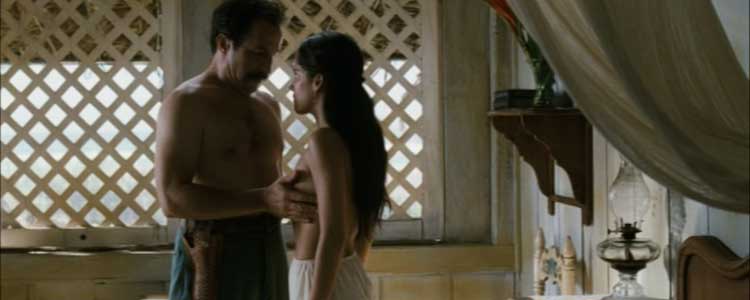On Tuesday, July 31, 2012, 6:00pmat St Agustine College
Address: 1345 W Argyle St, Chicago , IL | Cost: $20 or 2 for $30
Tear This Heart Out / Arráncame la vida
Director: Roberto Sneider
Mexico, 2008, 110 min.
At $6.5 million, Roberto Sneider’s newest film, Tear This Heart Out (Arráncame la vida) was the most expensive film to have ever been made in Mexico. This was in 2008. I remember first encountering Brotherhood of the Wolf (2001) in this way—one of the most expensive films shot in France—as well. While Brotherhood spent much of its money on special effects, Tear This Heart Out focused on locations, sets, wardrobe and delicious cinematography; truly, from curly art deco motifs unfurling while the credits roll to every single scene replete with the cooler color palettes of that era to geometric patterns quietly residing and pummeling out grids and order in every nook and cranny, there’s enough here to make even a literal realization of the movie eye candy.
The cast is just as beautiful starting with not just the lead female role, Catalina Ascencio (Ana Claudia Talancón), but with Catalina (Cati) as the keystone of a film appearing to be just another tragedy of love and betrayal. In reality, the film is all about what University of Washington Tacoma professor Cynthia Duncan refers to as nothing less than historical revisionism reshaping many wrongs with a focus on “the flip side of traditional nationalistic discourse, taking literally the feminist maxim that the personal is political as its point of departure.” Yawn, right? This does not sound like a recipe for a blockbuster. And it’s not. Instead, it’s an analysis of the novel from which the movie finds as its origin.
Written by Ángeles Mastretta in 1985 and adapted by Sneider, the novel version of Tear This Heart Out was deemed controversial. Mastretta was personally attacked and vilified for enjoying success because she comes from wealth and connections. Her novel was attacked for being closer to the more base renderings of chick lit than anything substantial. Duncan’s paper does very well in explaining away such vitriol by elucidating the complexities. She then shows how iconoclastic the novel really is through the lens of Mexico’s Golden Age of Cinema. And why through cinema? Because those movies played an important role in the novel. As Duncan states, “Cati goes to films, she has opinions about them, and at times she even patterns her behavior after roles she has seen portrayed on the silver screen.” In Sneider’s version, movies seem to play much less of a role.
I’m reminded of The Lord of the Rings when I think of this departure from the source text. While the screenplays from Tolkein’s texts succeeded wildly, they were also much abridged. One of the storylines that didn’t make it on screen had to do with the Elves and Plato’s Theory of Forms. What? you say? Yes. There’s not enough buttered popcorn and stadium seating in the world to make something like that palatable to movie audiences.
For Tear This Heart Out, it seems that this more complicated dimension of Cati was scrapped, allowing more focus on what does put butts in seats: sex, beauty and betrayal. Largely, it works. Cati’s husband, General Andres Ascencio (Daniel Giménez Cacho) charms and repulses when he needs to. Carlos Vives (José Maria de Tavira) succeeds as compelling and more true-to-love lover as well. When Cati and Carlos are first together, you see just how different they are in comparison to the scenes with Andres. In particular, I couldn’t get enough of how Cati would touch his hair—running her fingers through his beard to rubbing his chest. It took me a while to realize the subtlety and yet power residing in this small gesture. Just as subtle was the place of Cati as narrator.
In the novel as well as the film, Catalina-as-narrator does more than convey that she is telling the story; she becomes a god. While describing what happens on screen, she also exposes truth and motive that we wouldn’t have known otherwise. In essence, she is creator. By the simple and subtle act of the narrator’s voice being her voice, we are shown the prestige—or the magic making it possible. A voice by any other name would have changed the story to its core. Unfortunately, this gets a little lost in the grand sweep of the film. What we’re left with is the window dressing: the clever and mischievous qualities of Cati, the rough and tumble sex scenes and romance and the staying power of Cati herself.
This isn’t Roberto Sneider’s first run-in with a powerful, onscreen lady. In 2002, he produced Julie Taymor’s film, Frida. I hope I’m not the only one to notice the great similarity between the two films’ scenes involving the main characters in their youth. It’s a subtle similarity, and I like to think it’s not coincidence but the mark of Sneider himself. Perhaps this is a coincidence as well, but both films involved cheating men and the distraught women in their wake. For Frida Kahlo, she suffered but had her art. For Cati, at least in the book, she had her art, too. For Cati in the movie, this seemed less so. That is, unless you take a closer look.
